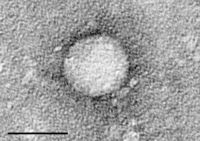
Photo from wikipedia
Dear Editor, It was with great enthusiasm that we read the article “Boerhaave’s syndrome: a differential diagnosis of chest and abdominal pain” published in the March/April 2018 issue of Radiologia… Click to show full abstract
Dear Editor, It was with great enthusiasm that we read the article “Boerhaave’s syndrome: a differential diagnosis of chest and abdominal pain” published in the March/April 2018 issue of Radiologia Brasileira. Although the article mentioned that the use of conventional imaging methods is of great value in the immediate detection of esophageal rupture, we would like to add some information to the text based on simple X-rays, given that the article provided only computed tomography images. In spontaneous esophageal rupture (Boerhaave’s syndrome), the diagnostic radiological finding is the V sign of Naclerio (Figure 1), identified on a chest X-ray as two hypertransparent Vshaped lines, one along the left border of the aorta and the other creating the continuous diaphragm sign on the left. The sign is produced by the presence of air between the left diaphragm and the descending aorta (vertical branch of the V) and between the left diaphragm and the parietal pleura (horizontal oblique branch of the V). The V sign was first described in 1957 by a thoracic surgeon, Emil A. Naclerio (1915–1985), in patients with rupture in the left posterolateral region of the esophagus. However, the sign is not pathognomonic and might not be seen in (iatrogenic or traumatic) lesions at the level of the proximal esophagus. Bladergroen et al. observed that esophageal lesions were iatrogenic, secondary to endoscopy, in up to 55% of cases; spontaneous in 15%; caused by a foreign body in 14%; and due to trauma in 10%. Other chest X-ray findings that indicate pneumoperitoneum include pneumopericardium, the continuous diaphragm sign, the continuous left hemidiaphragm sign, the V sign of brachiocephalic vein confluence, and the ring-aroundthe-aorta sign. Simple X-ray is a useful, practical, fast, and portable method that can be employed in severely ill patients hospitalized in closed units, which makes it a very important Rodolfo Mendes Queiroz1, Fernando Dias Couto Sampaio1, Pedro Eduardo Marques2, Marcus Antônio Ferez2, Eduardo Miguel Febronio1 1. Documenta – Hospital São Francisco, Ribeirão Preto, SP, Brazil. 2. Hospital São Francisco – Centro de Terapia Intensiva, Ribeirão Preto, SP, Brazil. Correspondence: Dr. Rodolfo Mendes Queiroz. Documenta – Hospital São Francisco. Rua Bernardino de Campos, 980, Centro. Ribeirão Preto, SP, Brazil, 14015-130. E-mail: [email protected]. which can reveal gas in the portal venous system (in 18% of cases) and hypodense vascular thrombi. Thrombosis of intrahepatic segments of the portal vein, the superior mesenteric vein, and the splenic mesenteric vein is observed in 39%, 42%, and 12% of cases, respectively, compared with only 2% for the inferior mesenteric vein. Unlike pneumobilia, gas in the portal venous system (hepatic portal venous gas) extends to the hepatic periphery. In cases of pylephlebitis, the most widely used therapy is the combination of anticoagulants and antibiotics. Surgical treatment is reserved for unresponsive cases and for resection of the inflammatory/infectious focus, as well as for drainage of large fluid collections and abscesses. The reported mortality rates range from 11% to 50%. Complications occur in 20–50% of cases, such complications including hepatic abscesses (in 37%), mesenteric venous infarction, chronic portal vein thrombosis, and portal hypertension.
Journal Title: Radiologia Brasileira
Year Published: 2018
Link to full text (if available)
Share on Social Media: Sign Up to like & get
recommendations!